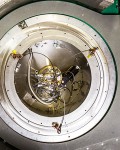OAK RIDGE, Tenn., July 10, 2015—Groundbreaking work at two Department of Energy national laboratories has confirmed plutonium’s magnetism, which scientists have long theorized but have never been able to experimentally observe. The advances that enabled the discovery hold great promise for materials, energy and computing applications.
Plutonium was first produced in 1940 and its unstable nucleus allows it to undergo fission, making it useful for nuclear fuels as well as for nuclear weapons. Much less known, however, is that the electronic cloud surrounding the plutonium nucleus is equally unstable and makes plutonium the most electronically complex element in the periodic table, with intriguingly intricate properties for a simple elemental metal.
While conventional theories have successfully explained plutonium’s complex structural properties, they also predict that plutonium should order magnetically. This is in stark contrast with experiments, which had found no evidence for magnetic order in plutonium.
Finally, after seven decades, this scientific mystery on plutonium’s “missing” magnetism has been resolved. Using neutron scattering, researchers from the Department of Energy’s Los Alamos and Oak Ridge (ORNL) national laboratories have made the first direct measurements of a unique characteristic of plutonium’s fluctuating magnetism. In a recent paper in the journal Science Advances, Marc Janoschek from Los Alamos, the paper’s lead scientist, explains that plutonium is not devoid of magnetism, but in fact its magnetism is just in a constant state of flux, making it nearly impossible to detect.





